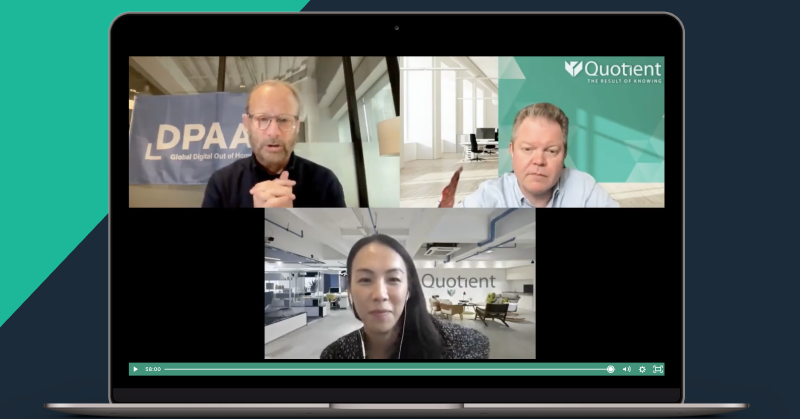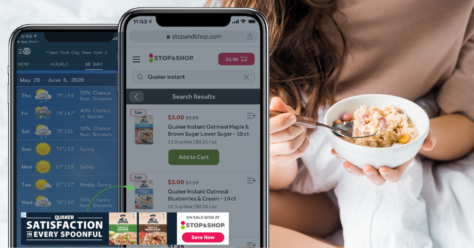Agency Leaders Talk Advancements in Programmatic DOOH
Programmatic digital out-of-home (DOOH) is redefining how advertisers and agencies think about brand awareness by unlocking measurable results through dynamic audience targeting. Together with the DPAA, Quotient’s DOOH Practice Lead Norm Chait and Group Director of Agency Development and Partnerships Susan Cho connected with leaders from some of the top out-of-home (OOH) agencies to discuss the evolution and adoption of programmatic DOOH.
Keep reading to uncover their top insights from the event.
How Programmatic Is Expanding DOOH
First up, Adrian Witter, Director of Programmatic and Partnerships at Kinetic Worldwide, explored the key factors in converting new adopters to programmatic DOOH. The channel has grown rapidly over the past few years, and with that growth comes new opportunities for brands. Whether it’s expanded ad inventory, national scale or the ability to support dynamic creative, the latest advancements in programmatic DOOH are giving marketers reasons to get excited.
Previously, some brands were hesitant to adopt OOH because they couldn’t apply digital best practices to campaign delivery and measurement. Thanks to recent technology developments, updated capabilities and increased inventory, however, DOOH now can more precisely target consumers by integrating brands’ first-party data. Importantly, its performance can also be measured and tied to attributable sales. This is huge for marketers who know their audience and want to connect with them in both the physical and digital worlds. Programmatic DOOH bridges that gap and, what’s more, can be integrated with other media efforts to create a true omnichannel campaign strategy.
“The focus on first-party data assets has become crucial to any agency and their clients that they act on behalf of ... Plus, the fact that we can measure and attribute performance to that delivery elevates the standing of out-of-home as a channel that can be used for the broad awareness and branding that it’s inherently known for but then also moves it over into more of the performance marketing model approaches that typifies a lot of the quicker tactical campaigns that come up on a consistent basis.”
Exploring the Importance of Measurement
Chet Foltyn, Media Supervisor at RapportWW, highlighted the importance of measurement during his session, citing it as one of the main reasons why he sees clients opt in to programmatic for the first time.
“Measurement is important for any line of business, but especially in programmatic out-of-home. We’re often giving [clients] a new approach that they haven’t tried before, so we want to show some type of learning objective. Measurement can help us set up for a future bigger and bolder recommendation. Without it, we may not be able to present the next programmatic campaign.”
Foltyn also emphasized the importance of flexibility when it comes to programmatic DOOH campaigns. During the pandemic, the flexibility to turn off campaigns when needed, change messaging or alter tactics to better fit the current landscape has been a huge plus for many brands. That same flexibility was a huge selling point in creating new adopters of programmatic DOOH because it enabled marketers to respond to changes in consumer behavior and movement in real time.
Three Key Strengths of Programmatic DOOH
When it comes to the main value proposition of programmatic DOOH compared to other media types, Adam Popkin, Group Director at Horizon Media, had three key points: flexibility, efficiency and consistency.
While flexibility is an often-highlighted strength, Popkin pointed out that the simplest things can have the biggest impact. Because of programmatic’s nimble response times, brands can quickly and easily respond to new opportunities. For example, take Horizon’s Mega Millions campaigns for the California State Lottery. Whenever the jackpot hits a certain threshold, they use programmatic DOOH to announce the number and create excitement among consumers. This is a big win for the client since they can’t predict when the jackpot will hit big numbers, so they need a quick-turn solution with customizable flight times.
Efficiency of time and consistency in data usage were also major focuses for Popkin’s session. Programmatic enables brands to preset parameters and activate DOOH ads automatically, saving them time on execution. Additionally, because marketers can use the same data to target niche audiences with DOOH ads as they do across other media platforms, clients can have confidence that they’re reaching their intended audience no matter the ad type.
"I think [there’s] an opportunity for clients to have real confidence that they can make creative that’s targeted to an out-of-home audience ... We can make creative that’s relevant to an audience, and that creative can be relevant across any type of place-based venue because you’re targeting the same audience all the way through it."
We hope you enjoyed discovering the many ways in which programmatic DOOH can work for your brand. To get started planning your next campaign, contact us at communications@quotient.com.




